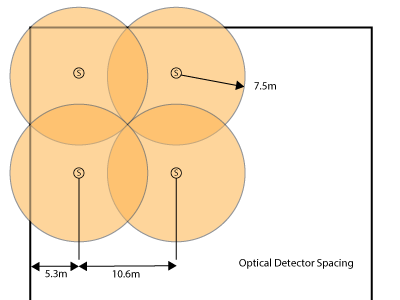Take a look at the spacing guidance below.
Smoke Detectors
Smoke detectors offer a coverage radius of 7.5m.
It's necessary to overlap the 7.5m circles of multiple detectors so that no areas are left uncovered. This is commonly done using squares which are laid out to cover a room.
For smoke detectors each square is 10.6m wide, this means a grid of lines 10.6m by 10.6m apart with detectors placed where the lines cross.
The 10.6m dimension is made up of two lots of 5.3m coming from 2 detectors. So the grid should start no more than 5.3m from the wall as coverage is only coming from one detector.
Heat Detectors
Heat detectors offer a coverage radius of 5.3m.
Like smoke detectors, it's necessary to overlap the circles of multiple detectors so that no areas are left uncovered. This is commonly done using squares which are laid out to cover a room.
For heat detectors, each square is 7.5m wide. This means a grid of lines 7.5m by 7.5m apart, with detectors placed where the lines cross.
The 7.5m dimension is made up of two lots of 3.75m coming from 2 detectors. So the grid should start no more than 3.75m from the wall as coverage is only coming from one detector.
Multi Detectors
Multi-detectors combine multiple technologies. If the multi-detector has heat-sensing capability, use the heat detector spacing above. If there is no heat-sensing capacity, use the smoke spacing above.
Carbon Monoxide Detectors
Carbon monoxide detectors should use the smoke spacing above.
Beam Detectors
Beam detectors offer 7.5m of coverage either side of the beam. 15m in total for each beam made up of 7.5m each side of the beam path.
Apex ceilings
Where detectors are fitted in the top of an apex ceiling there is a coverage uplift.
- Non heat detectors (Smoke/CO/Beam/Non heat Multi). In the top 600mm of the apex.
- Heat detectors. In the top 150mm of the apex.
Increase the coverage distances mentioned above by 1% for each degree of pitch up to a maximum of 25%.
So if there is a smoke head in the top 600mm of an apex with a 12 degree pitch the radius formula will be 7.5m * 1.12 = 8.4m.
Beams may also have their coverage uplifted where the beam passes through the top 600mm of the apex.
Want us to calculate everything & show you visually on your floor plan?
Click this button to see how Fire3D shows you the coverage for each device as you're designing. We do all the calculations automatically for you showing you visually what's covered with colored shapes overlaid on your floor plans.
Make designing a breeze.
P.s. We can also save you a fortune on Zone Plan costs. 💰🤫
Fire3D AI Detector Coverage Calculations
Fire3D calculates these coverage distances automatically and adjusts coverage based on the location of the detector in the room.
There are many other influences on detector coverage such as:
- Maximum device mounting heights
- Proximity to obstacles
- AC & HVAC
- Differing ceiling types
- And more...
Fire3D AI takes all of these into account when automatically calculating coverage for detectors. Taking care of this means faster quotes and estimates and cost effective designs which are not 'Over Specified' winning you more business.
Other Fire3D AI Coverage Calculations
The AI engine also calculates coverage and compliance for many other tests to ensure BS5839 compliance.
Some of these include:
- Risk assessment based device placements ensuring the correct coverage is in place to comply with the assessment.
- Sounder coverage based on sounder power and ambient decibels in each room.
- VAD coverage based on VAD classification, ambient LUX and daylight compensation in each room.
- MCP walking distance coverage based on floorplan layout and obstructions.
- High risk Rooms ensuring these have MCPs near.
- Fire & Rescue search distances based on floorplan layout, zoning, obstructions and visibility.
- And many more...
Try out Fire3D for yourself
Click the 'Click to see what Fire3D can do' button at the top of the page and start designing today.

